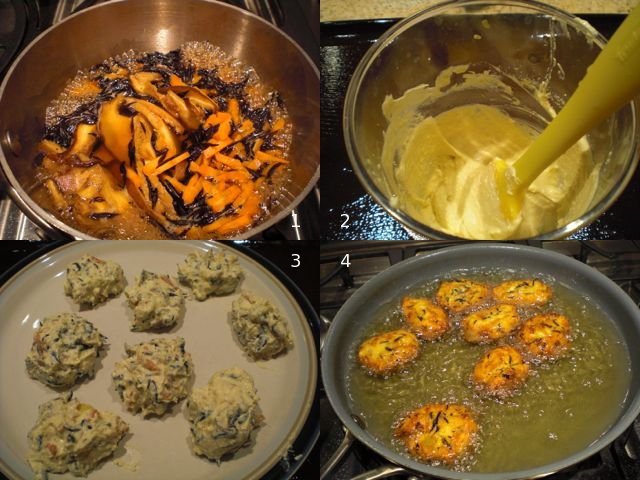Here I served it hot with grated ginger and soy sauce. (You can see a ginko nut peeking out of the cut surface.) There appear to be many theories as to the origin of the name. The corresponding kanji letter for ganmodoki is 雁擬き meaning "imitation goose" but this certainly does not resemble, in any way, shape or form, goose meat.

 I deep fried it in 170C (340F) vegetable oil until golden (#4, turning a few times, total time of 4-5 minutes).
I deep fried it in 170C (340F) vegetable oil until golden (#4, turning a few times, total time of 4-5 minutes).
I had 1/2 a block of soft tofu to use. I wrapped it in a paper towel and microwaved it for 1 and half minutes and let it cool down, allowing the excess water to be absorbed into the paper towel. I placed the tofu and a whole egg (1 large) in a plastic blending container and homogenized using an immersion blender (#2 in the image below). You can use a food processor or Japanese mortar, suribachi すり鉢, for this as well.
Other ingredients included; dried shiitake mushroom (1 large, hydrated, stem removed and thinly sliced), black sea weed called "hijiki" ひじき (dried 1 tbs), gobou (1/4 tail end, leftover from the New Year) and carrot (1/4 medium). For hijiki sea weed, this time, I used "me-hijiki" 芽ひじき which is shorter and smaller than long hijiki or naga-hijiki 長ひじき I posted before. After hydration (with several changes of water for 30 minutes), hijiki increased in volume by almost 10 fold. I squeezed out the excess moisture and combined with shredded gobout and carrot.* I added the soaking liquid from the shiitake (100ml) and simmered (#1 in the image below). I added mirin (2 tbs) and soy sauce (1 tbs) and further simmered on a low flame for 5-10 minutes until almost all the liquid was gone. I let it cool down and further removed any remaining liquid by squeezing. I added the mixture to the homogenized tofu and added potato starch (1 tsp or a bit more depending on the moisture level) and mixed well. Since I seasoned the vegetables, I did not add salt to the batter.
Moistening my hands with vegetable oil, I made small round disks (eight 2 inch diameter) and I also inserted ginko nuts (from a can) into the center (#3 in the image below). The batter was very soft and sticky. You could use two spoons in a manner similar to making quenelle and directly drop it in the oil.
* These were cut in "sasagaki" ささがき. In Japanese curinary parlance, sasagaki is to shave off vegetables (mostly thin long items such as gobou) as though you are sharpening a pencil. Supposedly, the shape of the resulting pieces resembles small bambo ("sasa" 笹) leaves.
Homemade and hot freshly fried ganmo has an all together different taste and texture from the frozen variety we are used to. Hot and crunchy on the outside you can't go wrong. Although, we have to admit, this does not remind us of goose meat, it is quite good on is own right. A perfect drinking snack especially with cold sake.




